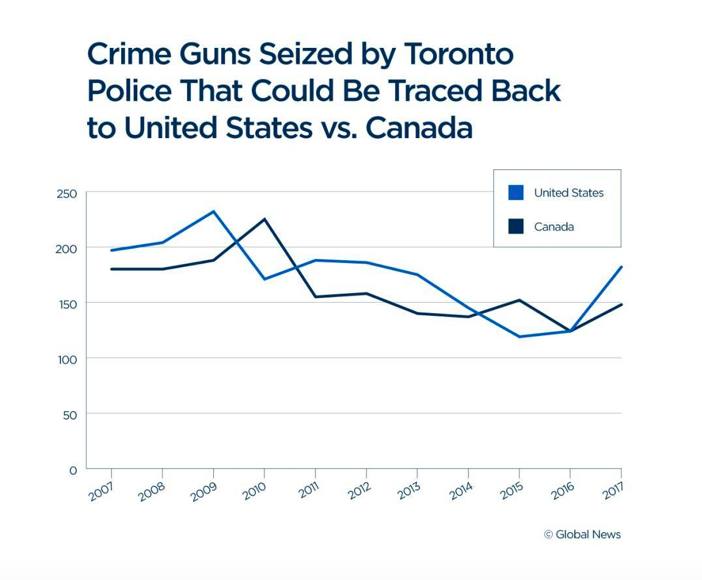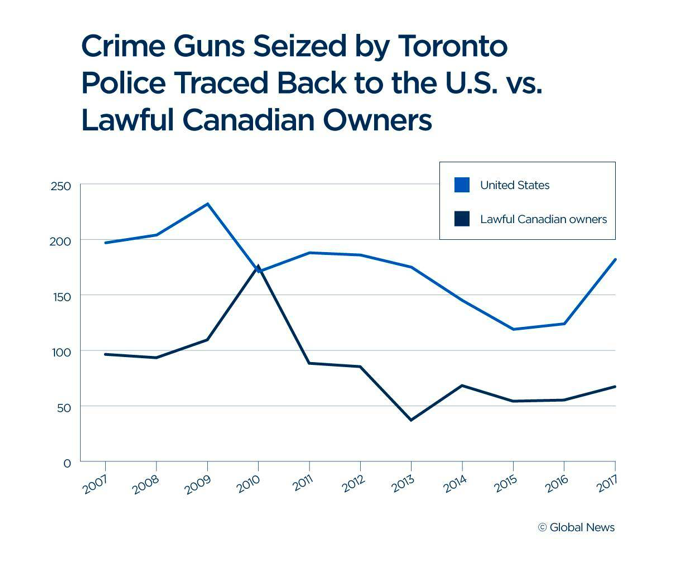Bad
information, once loose, persists. A false report is remembered long
after a correction. But the ongoing debate about gun control in Canada
is tainted by bad information. Let’s see what we can do about that.
Last
year was a violent one in Toronto. Shootings were sharply up. A new
record for homicides was set, with 96. In July, a particularly horrific attack in the Danforth neighbourhood left
two people dead and 13 more injured. Toronto mayor John Tory, a
generally sensible fellow who once (rightly) dismissed handgun bans as a
symbolic gesture, reversed himself and called for one. Tory claimed that his position had changed because the facts had changed — more handguns being used in Toronto crimes, he said, were being procured by licensed Canadian owners.
And it seemed like the mayor was onto something. The Canadian Press, shortly after the Danforth shooting, published an article quoting
a Toronto police detective at length. The article specifically claimed
that guns that could be traced back to Canada were now the leading
source for criminals in the city, eclipsing the traditional source:
smugglers bringing guns in from the United States.
The
number of “crime guns” — which in Toronto can mean not only guns used
in crime, but also those illegally altered, or seized during criminal
investigations — traced back to Canadian owners was “surging,” the
article reads. “[Some Canadians] go get their licence for the purpose of
becoming a firearms trafficker,” Det. Rob Di Danieli told the Canadian
Press.
The
Canadian Press provides news articles to most major news
organizations across the country, Global News included. The piece was
widely reprinted and was also cited in other reporting. It
directly supported a renewed call for a handgun ban in Canada, a call
that was taken up by city councils in Toronto and Montreal and is now
being studied by the federal Liberals, who have campaigned on a handgun
ban before — it was a key plank in Paul Martin’s failed 2006 campaign. It formed a central part of the debate that those calls provoked.
Its main claim — the
surge in domestic guns used in crimes beginning around 2012 — was
entirely based on the CP’s interview with Det. di Danieli. There
appeared to be no independent verification. Dennis R. Young, a
researcher and writer based in Alberta, filed a Freedom of Information
request with the Toronto police, seeking precise figures dating back
many years. The police obliged, and Young published the data verbatim online.
Below: Data shows the number of ‘crime guns’ seized by Toronto police based that can be traced back to Canada and the U.S.
|
|
|
In
September, I had obviously requested comment from Det. di Danieli and
the CP. The police acknowledged my request to speak to the detective,
and then never got back to me and ignored all follow ups. An editor at
the CP told me that they were aware of and looking into the matter, and
then ignored my follow ups.
This pissed me
off. Not in a sense of personal affront. I’ve been ignored before. But
this incident is, to my mind, a black mark for both the Toronto police
and the CP.
Policing and
reporting are both supposed to be about the truth. The police and the CP
had combined to put out inaccurate information, and that inaccurate
information was driving public debate. At minimum, a correction, or some
comparable acknowledgement, was absolutely required.
None came. Until a few days ago.
On Dec. 27, in that
quiet lull between Christmas and New Year’s, the Canadian Press
published a new article. It wasn’t a retraction or a correction to their
previous report. Indeed, the new article didn’t even refer directly to
the CP’s earlier reporting. The new CP article,
written by the excellent reporter Michelle McQuigge, detailed a
year-end press conference by Toronto Police Service Chief Mark Saunders.
And this article,
finally, sets the record straight. There indeed has been no surge in
crime guns traced back to legally-licensed Canadian owners. “[Firearms]
imported from the U.S. were implicated in … crimes more often than
domestically sourced firearms in eight of the past 11 years,” writes
McQuigge. “Domestically sourced crime guns only surpassed U.S. imports
in 2010 and 2015, with the two figures tied in 2016.”
As for the police,
they have also, ahem, expanded upon their earlier statements. They told
the CP that the majority of rifles and shotguns seized as crime guns by
Toronto police are linked back to Canadians (which doesn’t surprise
me). But they also finally admitted what should have been said months
ago. Again, quoting a Toronto police spokesperson from McQuigge’s piece:
“The majority of crime guns that are handguns seized by the Toronto
Police Service are sourced via the U.S.”
Well then.
Canadians have
spent four months having a debate, including public consultations, based
in part on bad information. Information that was known to be bad months
ago, but that went uncorrected until two days after Christmas, when
news readership is typically way, way below usual levels.
I’m not suggesting
for an instant that there is not a problem with domestically sourced
guns in Canada. The police definition of a crime gun is problematic — it
includes guns seized during investigations that may not ever have been
used in a crime, and also includes objects such as air guns that aren’t
firearms under the law. So you have to take some of the stats with a
grain of salt. But still. We should always have an open mind about ways
to make our gun control system more effective at reducing crime.
But
there is simply no evidence that there is a worsening problem among
lawful Canadian handgun owners, the people targeted by the proposed ban —
in effect, held up as partially responsible for tragic deaths and
senseless crimes. The Toronto police numbers don’t show it. Nationally,
the Public Safety Ministry has conceded
that it has no data to support claims by Minister Ralph Goodale that
domestic owners now provide the majority of crime guns. That entire
narrative, embraced wholeheartedly by the mayor and somewhat more
cautiously by federal Liberals, is based on bad information that should
not have been reported.
To call all this
disappointing would be an understatement. In an era when news
organizations all over the world are being accused of peddling fake
news, and when every police force recognizes the challenge of retaining
public trust, this is absolutely appalling.
I’m
a reasonable guy. Stuff happens. Errors are made. The public is owed
honesty, not perfection. Mistakes, when made, should be publicly
corrected, as quickly as possible. Four months is too long.
Canadians got
their honesty, eventually. Better late than never, I suppose. But damage
has been done. My satisfaction in the truth finally being acknowledged —
and there is some — is soured by that grim reality. Bad information
lasts forever.
All
we can do now, as properly informed citizens, is hold politicians
accountable when they repeat that bad information, whether they’re doing
so in ignorance or with malice. I’ll do my part. The rest is up to you.
https://globalnews.ca/news/4815321/despite-a-correction-canadas-gun-control-debate-is-still-tainted-by-bad-information/
Please share this.


No comments:
Post a Comment